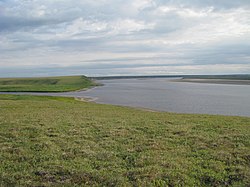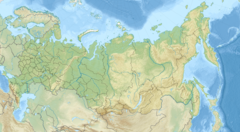| Revision as of 03:48, 8 February 2022 editXufanc (talk | contribs)Autopatrolled, Extended confirmed users, Pending changes reviewers85,539 edits cleaned up← Previous edit | Revision as of 03:50, 8 February 2022 edit undoXufanc (talk | contribs)Autopatrolled, Extended confirmed users, Pending changes reviewers85,539 edits sectionNext edit → | ||
| Line 62: | Line 62: | ||
| {{Reflist}} | {{Reflist}} | ||
| ==External links== | |||
| *{{commonscat inline|Anabar River}} | |||
| {{Authority control}} | {{Authority control}} | ||
Revision as of 03:50, 8 February 2022
River in Russia| Anabar Анабар / Анаабыр | |
|---|---|
 The Anabar near the mouth of the Polovinnaya The Anabar near the mouth of the Polovinnaya | |
 Anabar river basin Anabar river basin | |
 | |
| Location | |
| Country | Russia |
| Physical characteristics | |
| Source | |
| • location | Anabar Plateau |
| Mouth | Laptev Sea |
| • coordinates | 73°12′19″N 113°33′24″E / 73.2052°N 113.5567°E / 73.2052; 113.5567 |
| Length | 939 km (583 mi) |
| Basin size | 100,000 km (39,000 sq mi) |
| Discharge | |
| • average | 498 m/s (17,600 cu ft/s) |
The Anabar (Russian: Анабар, romanized: Anabar, in its upper course: Большая Куонамка Bolshaya Kuonamka; Template:Lang-sah) is a river in Sakha, Russia. It is 939 kilometres (583 mi) long, and has a drainage basin of 100,000 square kilometres (39,000 sq mi).
Course
The Anabar basin is located between the rivers Khatanga and Olenyok. Its catchment extends into the Putoran Mountains that form the highest part of the Central Siberian Plateau.
Its mean annual discharge is approximately 500 cubic metres per second (18,000 cu ft/s), concentrated heavily in early summer when the ice that covers the river for most of the year thaws. The mouth of the river is in the Gulf of Anabar.
History
Historically Evenks have inhabited the basin of the Anabar River. Vasiliy Sychev was the first Russian to reach the river in 1643.
In present times the basin of the Anabar river is notable as the location of the largest concentration of diamond deposits in the world outside of Africa and Australia. These deposits made the Soviet Union into one of the world's largest producers of diamonds, and remain the economic mainstay of the area.
See also
References
- "Река Анабар (Бол. Куонапка) in the State Water Register of Russia". textual.ru (in Russian).
- Forsyth, James (1992). A History of the Peoples of Siberia: Russia's North Asian colony 1581-1990. Cambridge: Cambridge University Press.
- Armstrong, Terence (2010). Russian Settlement in the North. Cambridge University Press.
- Holland, Clive (1994). Arctic Exploration and Development, c. 500 B.C. to 1915: an encyclopedia. New York: Garland.
External links
 Media related to Anabar River at Wikimedia Commons
Media related to Anabar River at Wikimedia Commons